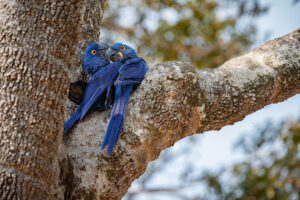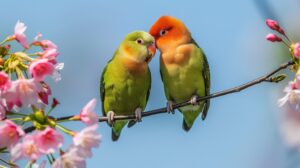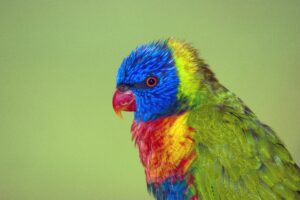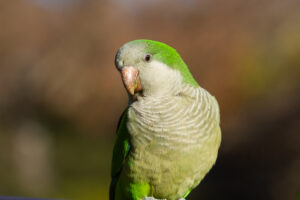Introduction
When considering exotic pet birds, the rose-breasted cockatoo often catches attention with its striking pink plumage and charismatic personality. Also known as the galah cockatoo, this Australian native has become increasingly popular in American aviculture. But is the rose-breasted cockatoo truly a suitable companion, or could it be among the most challenging pet birds to keep?
This comprehensive guide examines everything you need to know about the rose-breasted cockatoo—from care requirements and price considerations to temperament challenges and housing needs. Before you commit to this decades-long relationship, it’s essential to understand both the joys and difficulties of sharing your home with these intelligent and demanding parrots.

What is a Rose-Breasted Cockatoo?
The rose-breasted cockatoo (Eolophus roseicapilla), commonly called the galah cockatoo or simply galah, is a medium-sized parrot native to Australia. Among the most recognizable birds in Australian landscapes, the rose-breasted cockatoo features a distinctive pink and gray coloration that makes it stand out among other cockatoo species.
These birds are known for their:
- Pink breast, face, and crest feathers
- Light gray back and wings
- White underwing flashes visible during flight
- Round, stocky body type compared to other cockatoos
- Average size of 14 inches (35 cm) in length
In the wild, the rose-breasted cockatoo is highly social, forming large flocks that can include hundreds of birds. They’re adaptable creatures found across most of Australia’s mainland in various habitats, from woodland areas to urban environments. This adaptability has contributed to their success both in the wild and as companion animals.
Rose-Breasted Cockatoo vs. Other Cockatoos
When comparing the rose-breasted cockatoo to other popular cockatoo species like the umbrella cockatoo, several differences become apparent:
| Feature | Rose-Breasted Cockatoo | Umbrella Cockatoo |
|---|---|---|
| Size | Medium (14 inches) | Large (18-20 inches) |
| Noise Level | High, screechy calls | Very loud, more varied vocalizations |
| Temperament | Playful, can be moody | Often more affectionate, needier |
| Price | $1,500-$3,000 | $2,000-$4,000+ |
| Lifespan | 40-60 years | 50-70+ years |
The galah cockatoo vs umbrella cockatoo comparison often comes down to personality and care requirements. While umbrella cockatoos are frequently described as more consistently affectionate, rose-breasted cockatoos may offer a better balance between independence and interaction for some owners. Both require substantial time commitments, but many experienced bird keepers find the rose-breasted cockatoo slightly less demanding of constant attention.
Rose-Breasted Cockatoo Price and Acquisition

The rose-breasted cockatoo price typically ranges from $1,500 to $3,000 in the United States, depending on age, gender, breeding, and coloration. Hand-raised babies from reputable breeders command higher prices but often make better companions due to proper socialization.
When looking for a rose-breasted cockatoo for sale, consider these important factors:
- Source: Adopt from rescues when possible, or purchase from ethical breeders who raise birds in healthy environments.
- Health screening: Request health certifications and disease testing.
- Age: Young birds bond more easily but require more training; adult birds may have established personalities.
- Gender: Males and females have similar physical characteristics but can show slight temperament differences.
- Socialization history: Birds with positive human exposure make better companions.
Birds from pet stores often come with unknown backgrounds and potentially problematic early experiences. Additionally, legitimate breeders typically have waiting lists, so be wary of immediately available birds at suspiciously low prices.
Before bringing home a rose-breasted cockatoo, prepare for significant upfront costs beyond the bird’s purchase price:
- Quality cage: $500-$1,000
- Initial veterinary exam: $100-$200
- Toys and enrichment: $200-$300
- Food and nutrition: $100-$150 startup
- Perches and cage accessories: $150-$250
Rose-Breasted Cockatoo Lifespan and Long-Term Commitment
One crucial consideration when contemplating a rose-breasted cockatoo as a pet is their impressive lifespan. The rose-breasted cockatoo lifespan typically ranges from 40 to 60 years in captivity with proper care, making them a multi-decade commitment.
This extraordinary longevity means:
- Your rose-breasted cockatoo may outlive you, requiring estate planning
- The bird may need to transition between family members or homes
- Healthcare costs will accumulate over decades
- Housing situations must accommodate the bird for many years
- Training and behavior management is a long-term project
The rose-breasted cockatoo’s long life expectancy represents both a blessing and a responsibility. While their extended lifespan allows for deep bonds to form, it also necessitates careful future planning. Many cockatoos experience multiple homes throughout their lives, which can lead to behavioral issues and emotional distress for these sensitive creatures.
Rose-Breasted Cockatoo Care: Daily Requirements
Proper rose-breasted cockatoo care involves numerous daily commitments that significantly impact your schedule and lifestyle. These birds require consistent routines and dedicated attention to thrive in captivity.
Rose-Breasted Cockatoo Diet
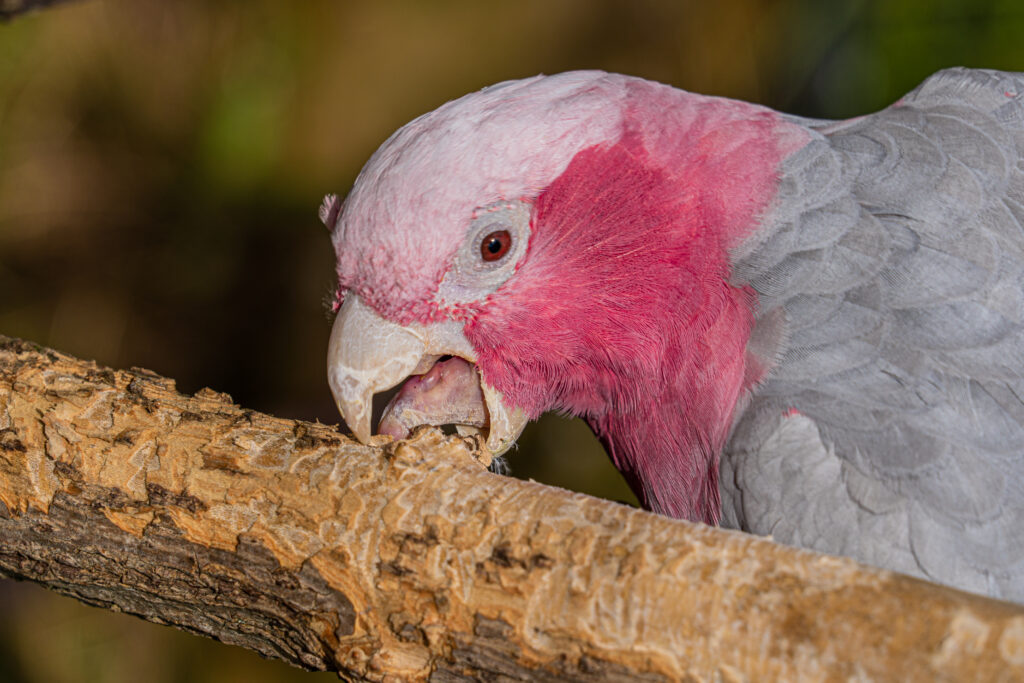
A nutritionally complete rose-breasted cockatoo diet should include:
- High-quality pellets: 50-60% of diet, providing balanced nutrition
- Fresh vegetables: 20-30%, particularly leafy greens, carrots, and sweet potatoes
- Limited fruits: 10%, offering natural sugars and vitamins (apples, berries, melons)
- Healthy seeds and nuts: 10-15%, emphasizing unsalted varieties like almonds and sunflower seeds
- Occasional treats: Very sparingly, as training rewards
Foods to avoid include:
- Avocado (toxic to birds)
- Chocolate and caffeine
- Alcohol
- Foods high in salt or sugar
- Onions and garlic
- Fruit seeds and pits (many contain cyanide compounds)
Daily feeding requires fresh food preparation, regular cleaning of dishes, and monitoring for dietary preferences and potential nutritional gaps. The rose breasted cockatoo, like many parrots, can develop picky eating habits that require patience and creativity to overcome.
Housing and Environment
The rose breasted cockatoo cage size should be substantial—at minimum 36″ W × 24″ D × 48″ H (91 × 61 × 122 cm), though larger is always better. Bar spacing should be 3/4″ to 1″ to prevent escape while allowing climbing opportunities.
Essential cage features include:
- Multiple perches of varying diameters and textures
- Food and water stations positioned away from perches
- Toys that promote foraging, chewing, and mental stimulation
- Easy-to-clean grates and trays
- Secure locks that prevent escape
Beyond the cage, rose breasted cockatoos need:
- Safe out-of-cage time (minimum 3-4 hours daily)
- Bird-proofed spaces free from hazards and toxic materials
- Consistent temperature (65-80°F/18-27°C)
- Natural light exposure (without overheating)
- Protection from drafts and air pollutants
Rose-Breasted Cockatoo Personality and Behavior
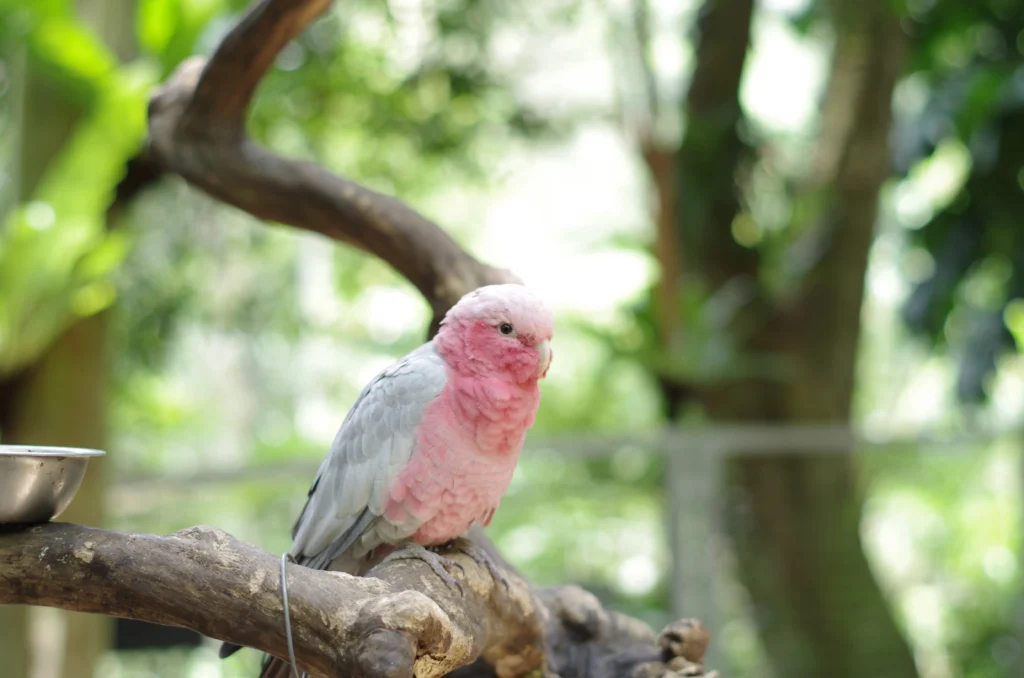
Understanding the rose-breasted cockatoo personality is essential for successful companionship. These birds are known for their complex emotional lives and distinctive behavioral traits.
Typical rose-breasted cockatoo behavior includes:
- Playfulness: They enjoy interactive toys and games
- Intelligence: Problem-solving abilities comparable to a 3-4 year old child
- Social bonding: Form strong attachments to favorite people
- Moodiness: Can switch from affectionate to irritable quickly
- Routine sensitivity: May become stressed by environmental changes
- Territorial tendencies: Sometimes protective of cage or favorite person
- Attention-seeking: Use noise and antics to gain human interaction
The rose-breasted cockatoo intelligence level allows them to learn numerous commands, solve puzzles, and even pick up human language. However, this intelligence requires constant stimulation to prevent boredom and associated behavioral problems.
Rose-Breasted Cockatoo Talking Abilities
Many prospective owners are attracted to the rose-breasted cockatoo talking potential. While not as prolific speakers as some parrot species, rose-breasted cockatoos can develop decent speech capabilities with consistent training.
Rose-breasted cockatoo talking typically includes:
- Learning 15-50 words or short phrases
- Male birds often developing larger vocabularies than females
- Speech that may be slightly muffled compared to other parrots
- Ability to associate words with contexts or objects
- Mimicry of household sounds (doorbells, phone rings, microwave beeps)
Training should begin early, using positive reinforcement and repetition. Daily speech sessions of 10-15 minutes yield better results than occasional longer sessions. Remember that each bird is an individual—some rose-breasted cockatoos become excellent talkers, while others prefer to communicate through other vocalizations or body language.
Noise Level and Vocal Behaviors
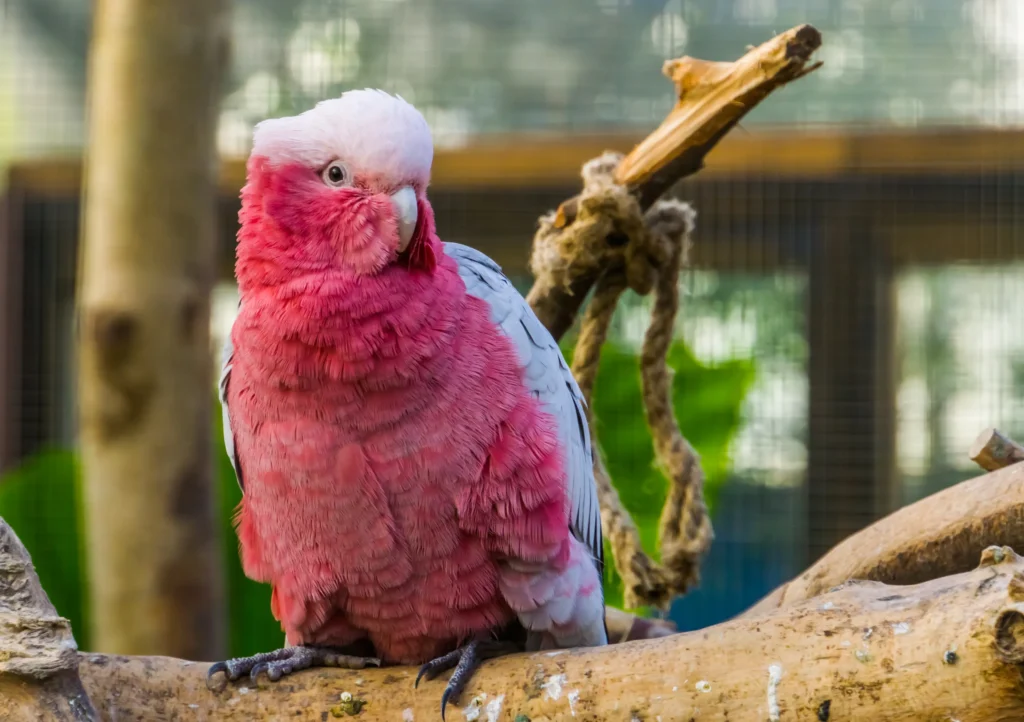
Among the most challenging aspects of rose-breasted cockatoo ownership is managing their noise. The rose-breasted cockatoo noise level ranks quite high among companion birds, with several distinct vocalizations:
- Contact calls: Loud screeches when separated from flock/family
- Alarm calls: Piercing, repetitive warnings when startled
- Dawn/dusk chorus: Vocalization periods at sunrise and sunset
- Attention-seeking cries: Persistent calls when wanting interaction
- Pleasure sounds: Quieter chattering and warbling when content
These calls can reach 120-135 decibels—comparable to a rock concert or jackhammer. This volume presents significant challenges for:
- Apartment or condo living
- Homes with close neighbors
- Households with young children or noise-sensitive individuals
- Work-from-home arrangements requiring quiet
While some vocalization is normal and healthy, excessive screaming often indicates unmet needs or stress. Environmental enrichment, consistent routines, and appropriate attention can help manage noise levels, but potential owners should accept that rose-breasted cockatoos will never be quiet pets.
Training Requirements
Successful rose-breasted cockatoo training requires patience, consistency, and positive reinforcement techniques. Essential training areas include:
- Step-up training: Teaching the bird to willingly climb onto your hand
- Crate/carrier training: For safe transportation to veterinary visits
- Recall training: Coming when called for safety
- Handling tolerance: Accepting wing, nail, and beak maintenance
- Social boundaries: Appropriate interaction with different people
Rose-breasted cockatoo training should begin immediately upon bringing the bird home and continue throughout their life. These intelligent birds respond well to clicker training, target training, and food rewards. Training sessions should be short (5-15 minutes) but frequent, focusing on one skill at a time.
Common training challenges include:
- Inconsistent responses to commands
- Testing boundaries during adolescence (2-5 years)
- Regression during molting or hormonal periods
- Resource guarding behaviors
- Selective listening with different family members
Are Rose-Breasted Cockatoos Good Pets?
The question “are rose-breasted cockatoos good pets?” has no simple answer—it depends entirely on the owner’s lifestyle, expectations, and commitment level.
Pros of Rose-Breasted Cockatoo Ownership:
- Intelligent and interactive companions
- Capable of deep emotional bonds
- Entertaining and playful behaviors
- Beautiful appearance
- Moderate size compared to larger cockatoos
- Potential for basic speech abilities
- Long lifespan allowing for lasting companionship
Cons of Rose-Breasted Cockatoo Ownership:
- Extremely loud vocalizations
- Significant time demands (4+ hours daily)
- Expensive care requirements
- Destructive chewing behaviors
- Potential for behavior problems including biting
- Dusty feathers that affect air quality
- Complex nutritional needs
- Multi-decade commitment
The rose-breasted cockatoo makes a wonderful companion for the right owner—someone who works from home or has flexible scheduling, lives in a detached house with tolerant neighbors, has experience with sensitive animals, and enjoys structured routines.
However, these birds are not suitable for:
- First-time bird owners
- People with unpredictable schedules
- Families planning significant life changes
- Those sensitive to noise or mess
- Households with small children or many other pets
- Anyone unwilling to make the bird a central part of daily life
Health Concerns and Veterinary Care
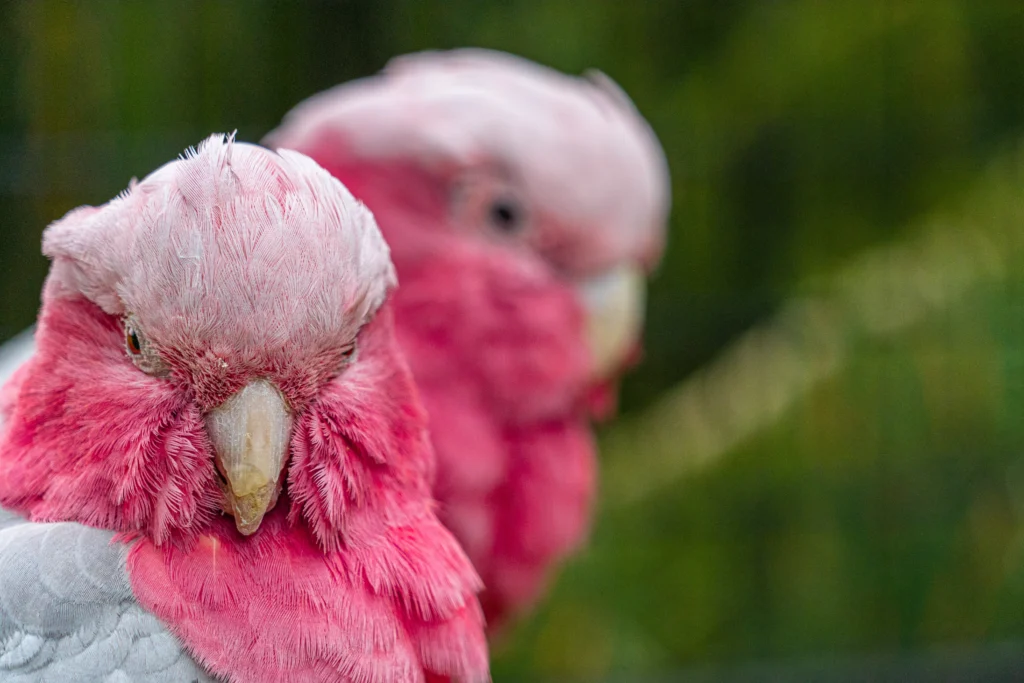
Responsible rose-breasted cockatoo care includes regular veterinary attention from an avian specialist. Common health issues include:
- Respiratory problems: Sensitive to airborne toxins and poor ventilation
- Psittacosis: Bacterial infection that can transfer between birds and humans
- Psittacine Beak and Feather Disease (PBFD): Viral condition affecting feather growth
- Nutritional deficiencies: Particularly calcium, vitamin A, and vitamin D3
- Obesity: From seed-heavy diets and insufficient exercise
- Behavioral issues: Feather picking, self-mutilation from stress or boredom
- Aspergillosis: Fungal infection affecting respiratory system
Preventative care should include:
- Annual veterinary examinations
- Periodic blood work and disease screening
- Proper nutrition and supplementation
- Weight monitoring
- Appropriate environmental humidity and cleanliness
Veterinary costs for rose-breasted cockatoos typically include:
- Routine annual exam: $75-$200
- Diagnostic testing: $200-$500
- Emergency care: $500-$2,000+
- Specialized treatments: Variable depending on condition
Enrichment and Mental Stimulation
The rose-breasted cockatoo’s high intelligence demands substantial mental stimulation to prevent destructive behaviors and emotional distress. Effective enrichment includes:
- Foraging opportunities: Food puzzles, hidden treats, and challenge toys
- Destructible items: Safe woods, cardboard, and plant materials for chewing
- Cognitive toys: Puzzles requiring problem-solving to access rewards
- Physical activity: Climbing structures, swings, and flight opportunities
- Social interaction: Direct play time with human companions
- Sensory enrichment: Varied textures, sounds, and visual stimulation
A well-stimulated rose-breasted cockatoo requires at least 12-15 different toys rotated regularly to prevent boredom. Budget $50-$100 monthly for replacement toys, as these birds quickly destroy their belongings.
Creating a Balanced Routine
One of the greatest challenges of rose-breasted cockatoo ownership is establishing and maintaining consistent routines. These birds thrive on predictability and can become stressed or behaviorally problematic when schedules change.
A typical daily routine might include:
Morning:
- Cage uncovering and greeting (sunrise or consistent early hour)
- Fresh food and water provision
- 30-60 minutes of direct interaction during morning activities
- Independent play time while owner prepares for the day
Daytime:
- Mid-day check-in if possible
- Environmental enrichment during alone time
- Cage placement allowing observation of household activity or outdoor views
Evening:
- Out-of-cage time (2-3 hours)
- Training session (10-15 minutes)
- Social interaction during family activities
- Fresh evening food
- Consistent bedtime routine and cage covering
Weekends and days off should maintain similar timing while allowing for extended interaction periods. When schedule disruptions are unavoidable, minimizing changes to morning and evening routines helps reduce stress.
Long-Term Management and Considerations
Beyond daily care, rose-breasted cockatoo owners must consider several long-term factors:
- Hormonal behaviors: Seasonal changes affecting temperament and increasing territorial behavior
- Social dynamics: Potential jealousy toward new household members or partners
- Home modifications: Bird-proofing, air filtration for dust, noise management
- Travel arrangements: Finding qualified bird sitters or boarding facilities
- Financial planning: Setting aside funds for ongoing care and potential medical needs
- Succession planning: Who will care for the bird if you cannot
For those wondering “are rose-breasted cockatoos good pets?” in the long term, consider that these birds often outlive marriages, job changes, moves, and other major life transitions. Their care must remain consistent despite these changes.
Conclusion: Is the Rose-Breasted Cockatoo the Worst Pet Bird?
While the provocative question “is the rose-breasted cockatoo the worst pet bird?” makes for an attention-grabbing headline, the reality is more nuanced. The rose-breasted cockatoo isn’t inherently a “bad” pet—but it is extraordinarily demanding in ways that make it unsuitable for most households.
The rose-breasted cockatoo’s challenging traits include:
- Deafening vocalizations
- Destructive capabilities
- Emotional sensitivity
- Time-intensive care requirements
- Considerable expense
- Decades-long commitment
- Complex social needs
For the unprepared owner, these traits can indeed make the rose-breasted cockatoo seem like the “worst” possible pet choice, leading to frustration, surrendered birds, and unhappy living situations. However, for the informed, dedicated caretaker with appropriate resources, these same birds can become beloved family members offering unparalleled companionship.
Before bringing a rose-breasted cockatoo into your home, honestly assess your:
- Noise tolerance
- Financial resources
- Available time
- Living situation stability
- Experience with avian behavior
- Long-term commitment capability
If, after realistic consideration, you determine that a rose-breasted cockatoo aligns with your lifestyle, be prepared for a rewarding but challenging relationship with one of the animal world’s most charismatic and complex companions.
Resources for Rose-Breasted Cockatoo Owners
For additional information about rose-breasted cockatoo care, consider these valuable resources:
- Avian Welfare Coalition – Information on proper bird care and welfare
- Association of Avian Veterinarians – Find qualified avian veterinarians
- BirdChannel.com – Articles and forums for bird owners
- World Parrot Trust – Conservation and care information
- Cockatoo Sanctuary and Rescue – Educational resources and rescue information
For more helpful guides about pet birds and their care, visit our website’s Bird Care Guides section, where you’ll find information about proper Bird Nutrition, Avian Health Issues, and Parrot Training Techniques.
Remember that responsible ownership begins with thorough research and honest self-assessment. The rose-breasted cockatoo deserves an owner prepared for its unique challenges and committed to providing lifelong appropriate care.



